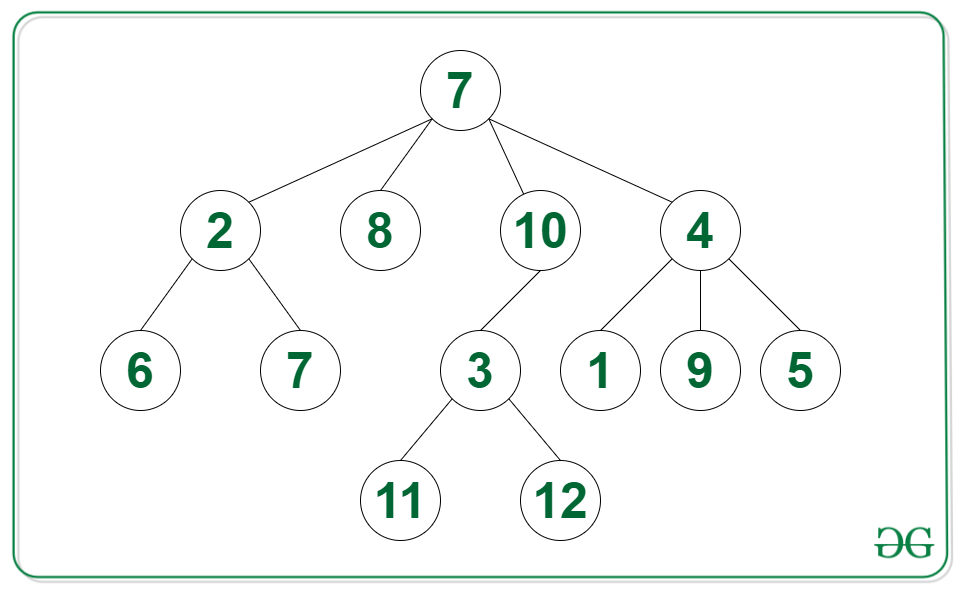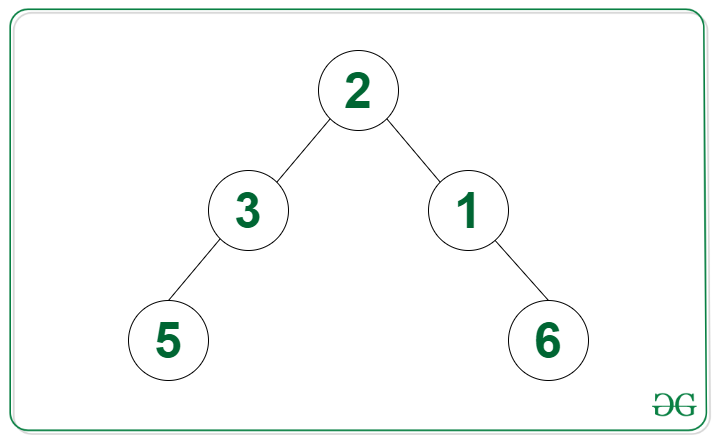给定 N 叉树中与子树中所有叶节点的距离相等的节点计数
给定一个 N 叉树根,任务是找到树中非叶节点的数量,使得当前节点的子树中的所有叶节点与当前节点的距离相等。
例子:
Input: Tree in the below image
Output: 4
Explanation: The nodes {10, 3, 2, 4} have the distance between them and all the leaf nodes in their subtree respectively as equal.

Input: Tree in the image below
Output: 3

方法:给定的问题可以通过使用后序遍历来解决。这个想法是检查从当前节点到其所有叶节点的节点数是否相同。可以按照以下步骤解决问题:
- 在 N 叉树上应用后序遍历:
- 如果根没有子节点,则返回 1 给父节点
- 如果每个分支的高度相等,则将计数增加 1 并将高度 + 1 返回给父级
- 否则返回 -1 给父级,表示分支高度不等
- 返回计数作为答案
C++
// C++ code for the above approach
#include
using namespace std;
class Node {
public:
vector children;
int val;
// constructor
Node(int v)
{
val = v;
children = {};
}
};
// Post-order traversal to find
// depth of all branches of every
// node of the tree
int postOrder(Node* root, int count[])
{
// If root is a leaf node
// then return 1
if (root->children.size() == 0)
return 1;
// Initialize a variable height
// calculate longest increasing path
int height = 0;
// Use recursion on all child nodes
for (Node* child : root->children)
{
// Get the height of the branch
int h = postOrder(child, count);
// Initialize height of first
// explored branch
if (height == 0)
height = h;
// If branches are unbalanced
// then store -1 in height
else if (h == -1 || height != h)
height = -1;
}
// Increment the value of count
// If height is not -1
if (height != -1)
count[0]++;
// Return the height of branches
// including the root if height is
// not -1 or else return -1
return height != -1 ? height + 1 : -1;
}
// Function to find the number of nodes
// in the N-ary tree with their branches
// having equal height
int equalHeightBranches(Node* root)
{
// Base case
if (root == NULL)
return 0;
// Initialize a variable count
// to store the answer
int count[1] = { 0 };
// Apply post order traversal
// on the tree
postOrder(root, count);
// Return the answer
return count[0];
}
// Driver code
int main()
{
// Initialize the tree
Node* seven = new Node(7);
Node* seven2 = new Node(7);
Node* five = new Node(5);
Node* four = new Node(4);
Node* nine = new Node(9);
Node* one = new Node(1);
Node* two = new Node(2);
Node* six = new Node(6);
Node* eight = new Node(8);
Node* ten = new Node(10);
Node* three = new Node(3);
Node* mfour = new Node(-4);
Node* mtwo = new Node(-2);
Node* zero = new Node(0);
three->children.push_back(mfour);
three->children.push_back(mtwo);
three->children.push_back(zero);
ten->children.push_back(three);
two->children.push_back(six);
two->children.push_back(seven2);
four->children.push_back(nine);
four->children.push_back(one);
four->children.push_back(five);
seven->children.push_back(ten);
seven->children.push_back(two);
seven->children.push_back(eight);
seven->children.push_back(four);
// Call the function
// and print the result
cout << (equalHeightBranches(seven));
}
// This code is contributed by Potta Lokesh Java
// Java implementation for the above approach
import java.io.*;
import java.util.*;
class GFG {
// Function to find the number of nodes
// in the N-ary tree with their branches
// having equal height
public static int equalHeightBranches(Node root)
{
// Base case
if (root == null)
return 0;
// Initialize a variable count
// to store the answer
int[] count = new int[1];
// Apply post order traversal
// on the tree
postOrder(root, count);
// Return the answer
return count[0];
}
// Post-order traversal to find
// depth of all branches of every
// node of the tree
public static int postOrder(
Node root, int[] count)
{
// If root is a leaf node
// then return 1
if (root.children.size() == 0)
return 1;
// Initialize a variable height
// calculate longest increasing path
int height = 0;
// Use recursion on all child nodes
for (Node child : root.children) {
// Get the height of the branch
int h = postOrder(child, count);
// Initialize height of first
// explored branch
if (height == 0)
height = h;
// If branches are unbalanced
// then store -1 in height
else if (h == -1 || height != h)
height = -1;
}
// Increment the value of count
// If height is not -1
if (height != -1)
count[0]++;
// Return the height of branches
// including the root if height is
// not -1 or else return -1
return height != -1 ? height + 1 : -1;
}
// Driver code
public static void main(String[] args)
{
// Initialize the tree
Node seven = new Node(7);
Node seven2 = new Node(7);
Node five = new Node(5);
Node four = new Node(4);
Node nine = new Node(9);
Node one = new Node(1);
Node two = new Node(2);
Node six = new Node(6);
Node eight = new Node(8);
Node ten = new Node(10);
Node three = new Node(3);
Node mfour = new Node(-4);
Node mtwo = new Node(-2);
Node zero = new Node(0);
three.children.add(mfour);
three.children.add(mtwo);
three.children.add(zero);
ten.children.add(three);
two.children.add(six);
two.children.add(seven2);
four.children.add(nine);
four.children.add(one);
four.children.add(five);
seven.children.add(ten);
seven.children.add(two);
seven.children.add(eight);
seven.children.add(four);
// Call the function
// and print the result
System.out.println(
equalHeightBranches(seven));
}
static class Node {
List children;
int val;
// constructor
public Node(int val)
{
this.val = val;
children = new ArrayList<>();
}
}
} Python3
# Python code for the above approach
class Node:
def __init__(self, val):
self.val = val
self.children = []
# Post-order traversal to find
# depth of all branches of every
# node of the tree
def postOrder(root, count):
# If root is a leaf node
# then return 1
if (len(root.children) == 0):
return 1
# Initialize a variable height
# calculate longest increasing path
height = 0
# Use recursion on all child nodes
for child in root.children:
# Get the height of the branch
h = postOrder(child, count)
# Initialize height of first
# explored branch
if (height == 0):
height = h
# If branches are unbalanced
# then store -1 in height
elif (h == -1 or height != h):
height = -1
# Increment the value of count
# If height is not -1
if (height != -1):
count[0] += 1
# Return the height of branches
# including the root if height is
# not -1 or else return -1
if(height != -1):
return height + 1
else:
return -1
# Function to find the number of nodes
# in the N-ary tree with their branches
# having equal height
def equalHeightBranches(root):
# Base case
if (root == None):
return 0
# Initialize a variable count
# to store the answer
count = [0]
# Apply post order traversal
# on the tree
postOrder(root, count)
# Return the answer
return count[0]
# Driver code
# Initialize the tree
seven = Node(7)
seven2 = Node(7)
five = Node(5)
four = Node(4)
nine = Node(9)
one = Node(1)
two = Node(2)
six = Node(6)
eight = Node(8)
ten = Node(10)
three = Node(3)
mfour = Node(-4)
mtwo = Node(-2)
zero = Node(0)
three.children.append(mfour)
three.children.append(mtwo)
three.children.append(zero)
ten.children.append(three)
two.children.append(six)
two.children.append(seven2)
four.children.append(nine)
four.children.append(one)
four.children.append(five)
seven.children.append(ten)
seven.children.append(two)
seven.children.append(eight)
seven.children.append(four)
# Call the function
# and print the result
print(equalHeightBranches(seven))
# This code is contributed by rj13to.C#
// C# implementation for the above approach
using System;
using System.Collections.Generic;
public class Node
{
public int val;
public List children;
// Constructor to create a Node
public Node(int vall)
{
val = vall;
children = new List();
}
}
class GFG {
// Function to find the number of nodes
// in the N-ary tree with their branches
// having equal height
public static int equalHeightBranches(Node root)
{
// Base case
if (root == null)
return 0;
// Initialize a variable count
// to store the answer
int[] count = new int[1];
// Apply post order traversal
// on the tree
postOrder(root, count);
// Return the answer
return count[0];
}
// Post-order traversal to find
// depth of all branches of every
// node of the tree
public static int postOrder(
Node root, int[] count)
{
// If root is a leaf node
// then return 1
if (root.children.Count == 0)
return 1;
// Initialize a variable height
// calculate longest increasing path
int height = 0;
// Use recursion on all child nodes
foreach (Node child in root.children) {
// Get the height of the branch
int h = postOrder(child, count);
// Initialize height of first
// explored branch
if (height == 0)
height = h;
// If branches are unbalanced
// then store -1 in height
else if (h == -1 || height != h)
height = -1;
}
// Increment the value of count
// If height is not -1
if (height != -1)
count[0]++;
// Return the height of branches
// including the root if height is
// not -1 or else return -1
return height != -1 ? height + 1 : -1;
}
// Driver code
public static void Main()
{
// Initialize the tree
Node seven = new Node(7);
Node seven2 = new Node(7);
Node five = new Node(5);
Node four = new Node(4);
Node nine = new Node(9);
Node one = new Node(1);
Node two = new Node(2);
Node six = new Node(6);
Node eight = new Node(8);
Node ten = new Node(10);
Node three = new Node(3);
Node mfour = new Node(-4);
Node mtwo = new Node(-2);
Node zero = new Node(0);
three.children.Add(mfour);
three.children.Add(mtwo);
three.children.Add(zero);
ten.children.Add(three);
two.children.Add(six);
two.children.Add(seven2);
four.children.Add(nine);
four.children.Add(one);
four.children.Add(five);
seven.children.Add(ten);
seven.children.Add(two);
seven.children.Add(eight);
seven.children.Add(four);
// Call the function
// and print the result
Console.WriteLine(
equalHeightBranches(seven));
}
}
// This code is contributed
// by Shubham Singh Javascript
输出
4时间复杂度: O(N)
辅助空间: O(H),其中 H 是树的高度